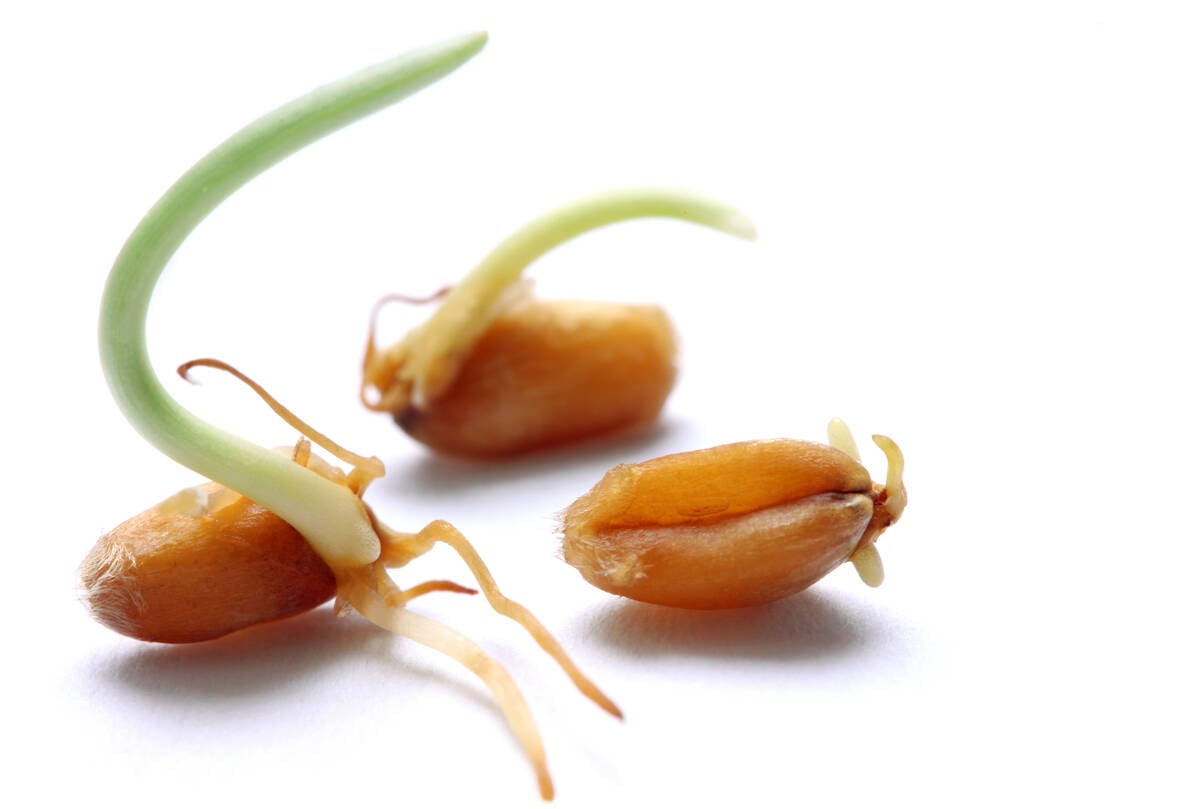Prairie crops | Aster yellows surprised producers in 2012, while blackleg continues to spread
Growers need to prepare themselves for an onslaught of disease next year.
There is plenty of inoculum in the soil after the “summer of disease,” said Sherrilyn Phelps, regional crop specialist with Saskatchewan Agriculture.
Disease is one of the main reasons why a 16 million tonne canola crop turned into 13.2 million tonnes. Farmers can take a number of steps to prevent that from happening again.
Saskatchewan’s canola disease survey found 77 percent of fields had some level of aster yellows infection with a mean incidence of eight percent infection.
Read Also

Manitoba farmers fight sprouted wheat after rain
Rain in mid-September has led to wheat sprouting problems in some Manitoba farm fields.
“I personally saw fields that were over 65 percent aster yellows,” Phelps told delegates attending the Agri-Trend 2012 Farm Forum Event.
She said a fellow agronomist at Meadow Lake, Sask., had a field that should have produced 40 bushels per acre but delivered seven because of aster yellows damage.
“I think we’ve underestimated some of the yield loss that resulted from aster yellows this year,” said Phelps.
Sclerotinia was found in 91 percent of the surveyed fields with a 19 percent level of infection, although some fields had more than 90 percent infection. The rule of thumb for that disease is yield loss generally amounts to half of the infection rate.
Blackleg infection is on the rise in Saskatchewan. Thirty-two percent of fields had the disease with a mean incidence of 3.7 percent.
The disease has particularly spiked in Alberta, where experts suspect varietal resistance is breaking down because growers are pushing canola rotations.
“That’s having a huge impact on the blackleg levels,” said Phelps.
Fusarium head blight was the biggest problem in cereals, with 82 percent of sampled fields in Saskatchewan containing at least one head infected with the disease.
Leaf diseases were prevalent, and ergot was an issue in pockets of the province.
High levels of mycosphaerella blight and ascochyta blight were found in pea fields in the northern grain belt.
There was also plenty of foot rot and root rot, which caused up to 50 percent yield loss in some pea fields.
The aphanomyces strain of root rot was discovered in Saskatchewan for the first time.
“It is one of the major root rot organisms in Manitoba, and worldwide is one of the most devastating root rot organisms. Once it’s in the soil it’s very, very hard to get rid of,” said Phelps.
It will be closely monitored next year.
Root rot and anthracnose were prevalent in lentil crops in west-central and southeastern Saskatchewan.
Phelps said producers should prepare to once again do battle with disease in 2013. The first line of defense is choosing seed with proper germination and vigour that is free of weed seeds and has an acceptable level of seed-borne diseases.
“The seed you plant is one of the factors that you do have control over,” she said.
Labs are reporting high levels of disease on tested seed.
Phelps encouraged growers to get their seed tested at an accredited lab because it gives them valuable information and provides documentation for insurance claims proving that the seed they planted was in good shape.
She stressed that growers should not plant wheat and barley seed containing any level of fusarium graminearum in regions where the disease is not common.
In areas where it is common, they should use another seed source when levels exceed five percent.
Seed treatments should be used when fusarium graminearum levels are between two and five percent in areas where the disease is common. A threshold of greater than five percent should be used for other species of fusarium.
Chickpeas should not be planted if seed contains more than 0.3 percent ascochyta blight. Seed treatments should be used on lentil seed containing more than five percent ascochyta blight, but growers should not use the seed if levels exceed 10 percent. Seed treatments should be used on peas containing more than 10 percent ascochyta.
Up to 10 percent sclerotinia and botrytis is tolerable on lentil and pea seed but will result in seedling blight without treatment. Fusarium infection should be added to the botrytis and sclerotinia numbers.
Phelps said a safe rule of thumb is that treatments provide 85 to 90 percent control. Treatment will bring the level of infection down to two to three percent if a seed lot has 20 percent fusarium, which is acceptable.
Growers are encouraged to stick to rotations to minimize disease, but Phelps recognizes that farmers often push rotations for financial reasons. If they do, they need to choose varieties resistant to disease, rotate their herbicides and plan on applying fungicide.
Farmers should definitely consider choosing disease resistant varieties next year.
Research from Melfort, Sask., shows that fungicide application on Harrington barley, which has poor disease resistance, improved yields by 19 to 30 percent. However, yields were boosted by only three to four percent on Newdale, which has fair to good resistance.
Growers may want to plan on more than one fungicide application. Timing of application is critical. Fungicide should be applied at the flag leaf stage of development for leaf diseases and at the heading stage for fusarium head blight.
Fungicide for sclerotinia in canola should be applied at the 20 to 50 percent bloom stage, ideally 30 percent when the crop is as yellow as it gets. For pulses, it should be applied at the early flower stage, seven to 14 days after the first fungicide application or when growers see symptoms.















